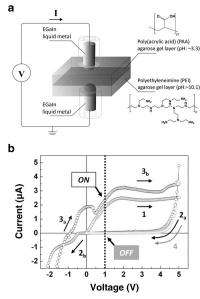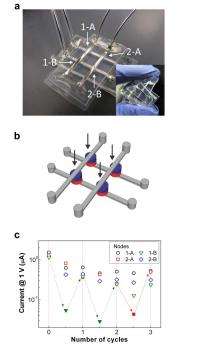July 28, 2011 feature
Memristors with a twist: Quasi-liquid soft matter foreshadows biocompatible electronics and flexible robots

In some circles, memristors (from "memory resistor," as coined by Leon Chua in a 1971 paper outlining memristive theory) are all the rage – and for good reason: As circuit elements which "remember" the amount of current that has passed through them in the past and show great functional flexibility, memristors show promise for applications as diverse as artificial synapses, nanoscale memory and sensors, and eventually a new class of computers based on neuromorphic architecture.
At the same time, the materials that make memristors (and electronic devices in general) possible are usually rigid in structure and can never operate in water. This means that some of the most promising uses of memristor technology – such as in vivo sensors and oceanic rescue robots – are not feasible without needing protection from the liquid environment in which they operate.
The best of all possible electronic worlds, then, would have the ion-based functionality of memristors embodied in a flexible hydrophilic material. As it turns out, that – and potentially much more – is precisely what researchers in the Department of Chemical and Biomolecular Engineering at North Carolina State University have demonstrated. Prof. Orin Velev, Prof. Michael Dickey, and graduate students Hyung-Jun Koo and Ju-Hee So, have devised a new class of easily fabricated memristors based entirely on so-called soft matter – hydrogels doped with polyelectrolytes sandwiched with liquid metal electrodes – that operate using ionic conductance in aqueous systems rather than conventional electron transport.
Moreover, in being able to operate in water, the new gel-based soft matter differs significantly from the many soft matter electronics efforts that use polymer semiconductors but are not water-compatible.
In essence, this suggests that in addition to having the potential to realize memristor-based neuromorphic structures, the polysaccharide hydrogel core of these devices is biocompatible, could possibly be interfaced with live neural and other tissue, and could lead to three-dimensional soft circuits and their in vivo operations.

Velev’s earlier work focused on gel-based photovoltaics, diodes and other devices – but their downside was the rigid electrodes used as contacts. Currently, however, the research team is studying a moldable liquid metal. “We originally thought about combining the metal with the gels to make a device completely out of soft materials resembling Jell-O,” quips Dickey. “What we discovered is that the gel environment and the oxide that forms on the metal can work synergistically to form memory. Once we made this observation, the main challenge was elucidating the exact mechanism – which our rather brilliant students figured out with some very clever experiments.”
More specifically, Dickey continues, “there are two key research issues that we addressed to make the technology work. The first was learning that the thickness of the oxide layer controls the resistance through the soft device – a property we use to define on and off states that correspond to conductive and resistive states, respectively. The second was learning that we could introduce asymmetry into the device – a requirement for memristors – by doping the gels with polymer to control the chemical environment around the metal.”
Going forward, Dickey continues, “We hope to take advantage of the fact the water-based gels in the device are biocompatible, and could in principle be integrated with biological species, such as cells, enzymes, proteins, and tissues. We also made no attempt to optimize the memory capacity in our prototypes, which is an area for improvement. Finally, we’re working to understand the subtle aspects of the operating mechanism.”
Velev stresses that two primary areas of the group’s future soft-matter research are electrochemical biosensors and soft-matter actuators. “For example,” he explains, “gel-based actuators respond to external voltage with controllable biomimetic movement that mimics the locomotion of jellyfish – and like jellyfish, are water-based and even biodegradable. This could lead to the development of gel-based soft robotics technology, which would have some parallels with DARPA’s earlier Soft Robotics program, although this similarity is not intended as much as arises from a shared focus on futuristic ideas that are based on mimicking Nature. I also believe,” he continues, “that our research ideas are close to some of the goals of the DARPA Programmable Matter program, but we are not supported by or participating in this program – although we hopefully will apply in the future after we have some actuation results.”
One of the most-discussed memristor characteristic is its synaptic biomimesis. “State-of-the-art computers have difficulty mimicking the operation of the brain,” Dickey notes. “Memristors, on the other hand, are effective at mimicking synapses. If you were interested in only mimicking brain function, then solid-state memristors would be more practical because they contain many more memory elements and are much more optimized at this point. One of the things distinguishing our work is that the device behaves like a memristor and has other properties similar to the brain. Conventional electronics tend to be rigid, 2-D, moisture-intolerant, and operate using electrons; the brain, in contrast, is soft, 3-D, wet, and operates using ions and in addition to adopting many of these properties, our device is composed of biocompatible hydrogels.”
Dickey points out that while the team has not demonstrated any interfacing of their soft-matter devices with biological species, and that it is unclear if it is even possible to interface with the brain, their technology “has many of the obvious properties one would look for this type of interface – including the ability to scale down to 10-100 microns in length. In fact,” he acknowledges, “we’ve just started a project to study the interface of these materials with neurons, but it is too early to comment on it.”
Velev is also cautiously optimistic that while he doesn’t foresee medical applications of the soft-matter devices at the moment, he agrees that “hypothetical interfacing with living neurons is possible.” The real strength of the group’s technology, he adds, is that “both neuronal tissue and soft matter use an ionic current to propagate signals. In the near future,” Velev adds, “likely applications include an advanced biocompatible matrix – for biomolecules and living cells, biosensors, and interfaces with mammalian cells other than neurons – immersed in water and biological fluids. While we’re not working on experiments involving live cells right now,” he concludes, “we’re hopeful that this could be a future development – potentially through new collaborations and funding.”
More information: Towards All-Soft Matter Circuits: Prototypes of Quasi-Liquid Devices with Memristor Characteristics, Advanced Materials; Article first published online July 4, 2011, DOI: 10.1002/adma.201101257
Copyright 2011 PhysOrg.com.
All rights reserved. This material may not be published, broadcast, rewritten or redistributed in whole or part without the express written permission of PhysOrg.com.


















